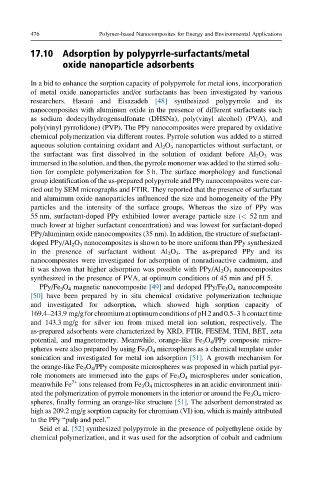Page 523 - Polymer-based Nanocomposites for Energy and Environmental Applications
P. 523
476 Polymer-based Nanocomposites for Energy and Environmental Applications
17.10 Adsorption by polypyrrle-surfactants/metal
oxide nanoparticle adsorbents
In a bid to enhance the sorption capacity of polypyrrole for metal ions, incorporation
of metal oxide nanoparticles and/or surfactants has been investigated by various
researchers. Hasani and Eisazadeh [48] synthesized polypyrrole and its
nanocomposites with aluminum oxide in the presence of different surfactants such
as sodium dodecylhydrogensulfonate (DHSNa), poly(vinyl alcohol) (PVA), and
poly(vinyl pyrrolidone) (PVP). The PPy nanocomposites were prepared by oxidative
chemical polymerization via different routes. Pyrrole solution was added to a stirred
aqueous solution containing oxidant and Al 2 O 3 nanoparticles without surfactant, or
the surfactant was first dissolved in the solution of oxidant before Al 2 O 3 was
immersed in the solution, and then, the pyrrole monomer was added to the stirred solu-
tion for complete polymerization for 5 h. The surface morphology and functional
group identification of the as-prepared polypyrrole and PPy nanocomposites were car-
ried out by SEM micrographs and FTIR. They reported that the presence of surfactant
and aluminum oxide nanoparticles influenced the size and homogeneity of the PPy
particles and the intensity of the surface groups. Whereas the size of PPy was
55 nm, surfactant-doped PPy exhibited lower average particle size (< 52 nm and
much lower at higher surfactant concentration) and was lowest for surfactant-doped
PPy/aluminum oxide nanocomposites (35 nm). In addition, the structure of surfactant-
doped PPy/Al 2 O 3 nanocomposites is shown to be more uniform than PPy synthesized
in the presence of surfactant without Al 2 O 3 . The as-prepared PPy and its
nanocomposites were investigated for adsorption of nonradioactive cadmium, and
it was shown that higher adsorption was possible with PPy/Al 2 O 3 nanocomposites
synthesized in the presence of PVA, at optimum conditions of 45 min and pH 5.
PPy/Fe 3 O 4 magnetic nanocomposite [49] and dedoped PPy/Fe 3 O 4 nanocomposite
[50] have been prepared by in situ chemical oxidative polymerization technique
and investigated for adsorption, which showed high sorption capacity of
169.4–243.9 mg/gfor chromiumatoptimumconditionsofpH2and0.5–3 hcontact time
and 143.3 mg/g for silver ion from mixed metal ion solution, respectively. The
as-prepared adsorbents were characterized by XRD, FTIR, FESEM, TEM, BET, zeta
potential, and magnetometry. Meanwhile, orange-like Fe 3 O 4 /PPy composite micro-
spheres were also prepared by using Fe 3 O 4 microspheres as a chemical template under
sonication and investigated for metal ion adsorption [51]. A growth mechanism for
the orange-like Fe 3 O 4 /PPy composite microspheres was proposed in which partial pyr-
role monomers are immersed into the gaps of Fe 3 O 4 microspheres under sonication,
meanwhile Fe 3+ ions released from Fe 3 O 4 microspheres in an acidic environment initi-
ated the polymerization of pyrrole monomers in the interior or around the Fe 3 O 4 micro-
spheres, finally forming an orange-like structure [51]. The adsorbent demonstrated as
high as 209.2 mg/g sorption capacity for chromium (VI) ion, which is mainly attributed
to the PPy “pulp and peel.”
Seid et al. [52] synthesized polypyrrole in the presence of polyethylene oxide by
chemical polymerization, and it was used for the adsorption of cobalt and cadmium

